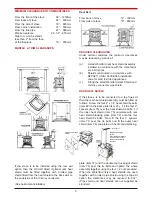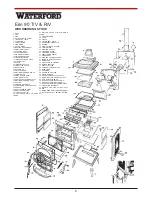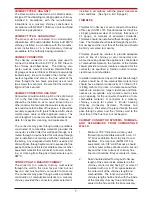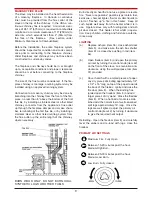
MAINTENANCE
CREOSOTE -
Formation and the need for removal.
When wood is burned slowly, it produces tar and
other organic vapours, which combine with expelled
moisture to form creosote. The creosote vapours
condense in the relatively cool chimney flue of a
slow burning fire. As a result creosote residue accu-
mulates on the flue lining. When ignited this cre-
osote makes an extremely hot fire. The chimney
connector and chimney should be inspected at least
twice monthly during the heating season to deter-
mine if a creosote build-up has occurred. If creosote
has accumulated it should be removed to reduce the
risk of chimney fire.
Inspect the chimney connector frequently. Tap the
connector with your finger when the pipe is cool. If
you hear a dull echo, the pipe may need cleaning.
Disassemble the chimney connector and clean the
sections. Replace corroded pipe sections. The fit-
ting of a slip-joint in the stove makes the dismantling
easy for cleaning and inspection of chimney and
stove.
When inspecting a masonry chimney, start at the
cleanout door, normally found in the basement, at
the base of the chimney, or on the outside. If your
chimney does not have a clean-out door it must be
inspected and cleaned by removing stove from
chimney.
GLASS REPLACEMENT
(a)
Open the firedoor (item 8) fully.
(b)
Remove the four corner screws and clips
(items 38 & 39) and carefully remove the
broken glass.
(c)
Clean the glass recess in the door.
(d)
Attach adhesive thermal tape to the
perimeter of the replacement glass.
11
(e)
Place the thermal taped side of the glass into
the firedoor recess and replace the four
corner clips (items 38 & 39) and screws.
(f)
Make sure that the large corner clip (item 39)
is fitted in the top right hand corner.
(g)
Tighten screws.
(h)
Replace glass only with ceramic glass 3/16”
(5mm) thick.
GLASS CLEANING
The glass will clean itself when there is sufficient
heat generated by the burning fuel. If a build-up of
creosote occurs on the glass due to poor draught
conditions, poor quality fuel or very low burning for
long periods of time, it is best to clean the glass
manually when glass is thoroughly cooled.
VITREOUS ENAMEL CLEANING
General cleaning must be carried out when the
stove is cool.
If this stove is finished in a high gloss vitreous
enamel, to keep the enamel in the best condition
observe the following tips:
1.
Wipe over daily with a soapy damp cloth,
followed by a polish with a clean dry duster.
2.
For stubborn deposits a soap impregnated
pad can be carefully used on the vitreous
enamel.
3.
Use only products recommended by the
Vitreous Enamel Department Council, these
products carry the Vitramel label.
4.
DO NOT USE ABRASIVE PADS OR OVEN
CLEANSERS CONTAINING CITRIC ACID
ON ENAMELLED SURFACES. ENSURE
THAT THE CLEANSER MANUFACTUR
ERS INSTRUCTIONS ARE ADHERED TO.






























